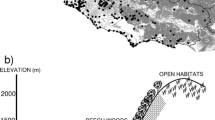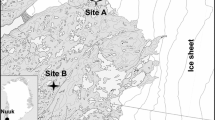Abstract
Understanding regional variability in species richness is necessary for conservation efforts to succeed in the face of large-scale environmental deterioration. Several analyses of North American vertebrates have shown that climatic energy provides the best explanation of contemporary species richness patterns. The paucity of analyses of insect diversity patterns, however, remains a serious obstacle to a general hypothesis of spatial variation in diversity. We collected species distribution data on a North American beetle genus, Epicauta (Coleoptera: Meloidae) and tested several major diversity hypotheses. These beetles are generally grasshopper egg predators as larvae, and angiosperm herbivores as adults. Epicauta richness is highest in the hot, dry American southwest, and decreases north and east, consistent with the species richness-energy hypothesis. Potential evapotranspiration, which is also the best predictor of richness patterns among North American vertebrates, explains 80.2% of the variability in Epicauta species richness. Net primary productivity and variables measuring climatic heat energy only (such as PET) are not generally comparable, though they are sometimes treated as if they were equivalent. We conclude that the species richness-energy hypothesis currently provides a better overall explanation for Epicauta species richness patterns in North America than other major diversity hypotheses. The observed relationship between climatic energy and regional species richness may provide significant insight into the response of ecological communities to climate change.
Similar content being viewed by others
References
Begon M, Harper JL and Townsend CR (1996) Ecology: Individuals, Populations, and Communities. Blackwell Science, Boston
Ceballos G and Brown JH (1995) Global patterns of mammalian diversity, endemism, and endangerment. Conservation Biology 9: 559–568
Currie DJ and Paquin V (1987) Large-scale biogeographic patterns of species richness of trees. Nature 329: 326–327
Currie DJ (1991) Energy and large-scale patterns of animal and plant species richness. American Naturalist 137: 27–49
Davis AJ, Jenkinson LS, Lawton JH, Shorrocks B and Wood S (1998) Making mistakes when predicting shifts in species range in response to global warming. Nature 391: 783–785
Eggleton P, Williams PH and Gaston KJ (1994) Explaining global termite diversity: productivity or history? Biodiversity and Conservation 3: 318–330
Ehrlich PR and Ehrlich AH (1992) The value of biodiversity. Ambio 21: 219–226
Fraser RH and Currie DJ (1996) The species-richness-energy hypothesis in a system where historical factors are though to prevail: coral reefs. American Naturalist 148: 138–159
Fraser RH (in press) Vertebrate species richness at the mesoscale: relative roles of energy and heterogeneity. Global Ecology and Biogeography Letters
Gaston KJ, Blackburn TM and Spicer J I (1998) Rapoport's rule: time for an epitaph? TREE 13: 70–74
Kerr JT (1997) Species richness, endemism, and the choice of areas for conservation. Conservation Biology 11: 1094–1100
Kerr JT and Currie DJ (1995) Effects of human activity on global extinction risk. Conservation Biology 9: 1528–1538
Kerr JT and Packer L (1997) Habitat heterogeneity as a determinant of mammal species richness in high-energy regions. Nature 385: 252–254
Kerr JT and Packer L (1998) The impact of climate change on mammal diversity in Canada. Environmental Monitoring & Assessment 49: 263–270
Kerr JT, Vincent RL and Currie DJ (in press) Determinants of Lepidoptera richness in North America. EcoScience
Kremen C, Colwell RK, Erwin TL, Murphy DD, Noss RF and Sanjayan MA (1993) Terrestrial arthropod assemblages: their use in conservation planning. Conservation Biology 7: 796–808
Kukal O, Ayres MP and Scriber JM (1991) Cold tolerance of the pupae in relation to the distribution of swallowtail butterflies. Canadian Journal of Zoology 69: 3028–3037
Lieth H (1975) Modelling the primary productivity of the world. In: Lieth H and Whittaker RH (eds) Primary Productivity of the Biosphere, pp 237–263. Springer-Verlag, New York
MacArthur RH (1972) Geographical Ecology. Harper and Row, New York
Margules CR, Nicholls AO and Pressey RL (1988) Selecting networks of reserves to maximise biological diversity. Biological Conservation 43: 63–76
May RM (1988) How many species are there on Earth? Science 241: 1441–1449
May RM, Lawton JH and Stork N (1995) Assessing extinction rates. In: May RM and Lawton JH (eds) Extinction Rates, pp 1–24. Oxford University Press, New York
Parmesan C (1996) Climate and species' range. Nature 382: 765–766
Pearson DL, Barraclough TG and Vogler AP (1997) Distributional range maps for North American species of tiger beetles (Coleoptera: Cicindelidae). Cicindela 29: 33–84
Peters RL and Darling JD (1985) The greenhouse e€ect and nature reserves. BioScience 35: 707
Peters RL and Lovejoy TE (1992) Global Warming and Biological Diversity. Yale University Press, New Haven
Pianka ER (1996) Latitudinal gradients in species diversity: a review of concepts. American Naturalist 100: 33–46
Pinto JD (1991) The taxonomy of North American Epicauta (Coleoptera: Meloidae), with a revision of the nominate subgenus and a survey of courtship behavior. University of California Press, Berkeley, CA
Pressey RL, Johnson IR and Wilson PD (1994) Shades of irreplaceability: towards a measure of the contribution of sites to a reservation goal. Biodiversity and Conservation 3: 242–262
Rohde K (1993) Rapoport's rule does not apply to marine teleosts and cannot explain latitudinal gradients in species richness. American Naturalist 142: 1–16
Rohde K (1996) Rapoport's rule is a local phenomenon and cannot explain latitudinal gradients in species diversity. Biodiversity Letters 3: 10–13
Root T (1988) Energy constraints on avian distributions and abundances. Ecology 69: 330–339
Rosenzweig ML (1995) Species Diversity in Space and Time. Cambridge University Press, Cambridge
Scheel D, Vincent TLS and Cameron GN (1996) Global warming and the species richness of bats in Texas. Conservation Biology 10: 452–464
Shmida A and Wilson MV (1985) Biological determinants of species diversity. Journal of Biogeography 12: 1–20
Soulé ME (1990) The real work of systematics. Annals of the Missouri Botanical Gardens 77: 4–12
Stevens GC (1989) The latitudinal gradient in geographical range: how so many species coexist inc. the tropics. American Naturalist 133: 240–256
Stevens GC (1992) The elevational gradient in altitudinal range: an extension of Rapoport's latitudinal rule to altitude. American Naturalist 140: 893–911
Turner JRG, Gatehouse CM, Corey CA (1987) Does solar energy control organic diversity? Butterflies, moths and the British climate. Oikos 48: 195–205
Wilson EO (1987) The little things that run the world. Conservation Biology 1: 344–346
Wilson EO (1992) The Diversity of Life. Harvard University Press, Cambridge
Wright DH, Currie DJ, Maurer BA (1993) Energy supply and patterns of species richness on local and regional scales. In: Ricklefs RE and Schluter D (eds) Species Diversity in Ecological Communities, pp 66–74. University of Chicago Press, Chicago
Zar JH (1984) Biostatistical Analysis. Prentice-Hall, Toronto
Author information
Authors and Affiliations
Rights and permissions
About this article
Cite this article
Kerr, J.T., Packer, L. The environmental basis of North American species richness patterns among Epicauta (Coleoptera: Meloidae). Biodiversity and Conservation 8, 617–628 (1999). https://doi.org/10.1023/A:1008846131749
Issue Date:
DOI: https://doi.org/10.1023/A:1008846131749




